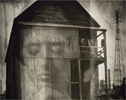
Each lesson below was written by an elementary teacher from the Los Angeles area. Developed through the Getty Education Department's one-year professional-development program, Art & Language Arts, these lessons were designed to meet California content standards for English–language arts and visual arts.
For more information about the program, please e-mail teacherprograms@getty.edu.
|
 |
|
 |
 |
Lessons 21–30 of 41 |
 |
 |
 |
 |
 |

  |
 |
Finding the Animals: A Visual Exploration of Art
Grades/Level: Lower Elementary (K–2)
Subjects: Visual Arts, English—Language Arts
Lesson Overview: Students participate in a "thirty-second look," followed by a class discussion about Jan Brueghel's painting The Entry of the Animals into Noah's Ark. Students then use description words and complete sentences to write about their favorite animal in the painting; draw the animal using line, color, and shape; and present their work to the class.
|
 |
 |
 |
Transforming Negatives into Positives
Grades/Level: Upper Elementary (3–5)
Subjects: Visual Arts, English—Language Arts
Lesson Overview: Students create double-exposed photographs, poetry, and multimedia presentations to celebrate their Open Court "City Wildlife" unit.
|
 |
 |
 |
Flora and Fauna as Figures of Speech
Grades/Level: Upper Elementary (3–5)
Subjects: Visual Arts, English—Language Arts
Lesson Overview: Students will view artwork in manuscripts pages depicting insects, animals, plants, flowers, and ornate writing, such as those found in the Mira calligraphiae monumenta in the Getty Museum. They will create a work of art that illustrates a figurative saying with a drawing of flora and/or fauna, and text written in ornate script.
|
 |
 |
 |
Giants of the Past
Grades/Level: Upper Elementary (3–5)
Subjects: Visual Arts, English—Language Arts
Lesson Overview: After reading The Mysterious Giant of Barletta by Tomie DePaola, about an ancient Roman statue that comes to life, students create a paper sculpture based on ancient Greek and Roman statues in the Getty Museum. They then write a narrative story told from the viewpoint of their sculpture.
|
 |
 |
 |
Puzzle Mystery
Grades/Level: Upper Elementary (3–5)
Subjects: Visual Arts, English—Language Arts
Lesson Overview: Your students will have fun trying to solve a mystery in this lesson. Students are given a small detail of a painting, which they sketch and then give a title. Students shares their titles and try to determine the theme and subject of the full painting based on these clues. At the end of class the students put their details together like a puzzle to create a class reproduction of the painting.
|
 |
 |
 |
Story Books
Grades/Level: Upper Elementary (3–5)
Subjects: Visual Arts, English—Language Arts
Lesson Overview: Students will discuss a narrative work of art in order to interpret and understand the theme from the Open Court unit on "Risks and Consequences." Students imagine the events occurring before and after a narrative scene, sketch their ideas, then write a story describing the action and publish their story and illustrations in a book. The works of art and sketches provide a focus to practice writing three-part stories with dialogue and using adjectives and prepositions.
|
 |
 |
 |
I Spy (Camouflaged Animals in Art!)
Grades/Level: Lower Elementary (K–2)
Subjects: Visual Arts, English—Language Arts, Science
Lesson Overview: Students discuss how the environment influences animal characteristics by looking at Hans Hoffmann's painting A Hare In the Forest. After the discussion, students research an animal that uses camouflage, paint that animal within its environment, and write a sentence describing its habitat. Students use this as a basis on which to write a sequential narrative about their animal and its relationship to its environment. This lesson is an extension to the Open Court Reader second grade unit on animal camouflage called "Look Again."
|
 |
 |
 |
Create an Illuminated Alphabet Word Book
Grades/Level: Lower Elementary (K–2)
Subjects: Visual Arts, English—Language Arts
Lesson Overview: Students create a class alphabet book or "ABCDarium," a book that uses images of animals or objects to illustrate each letter of the alphabet. The book is in the style of a medieval illuminated manuscript and incorporates both art and writing. Students decorate large uppercase letters of the alphabet and draw an original picture to illustrate each letter.
|
 |
 |
 |
Are You Sleeping?
Grades/Level: Lower Elementary (K–2)
Subjects: Visual Arts, English—Language Arts, Mathematics
Lesson Overview: Students participate in a measurement lesson focusing on length. They use their feet as the unit of measurement for furniture in the classroom and at home. They then sketch the pieces of furniture they measured.
|
 |
 |
 |
Buildings, Buildings Everywhere
Grades/Level: Upper Elementary (3–5)
Subjects: Visual Arts, English—Language Arts
Lesson Overview: Students gain awareness of shapes in architecture by creating a painting of their school and writing a reflective summary of their study of architecture.
|
 |
 |
 |
 |
 |
 |
Lessons 21–30 of 41 |
 |
 |
 |
 |
 |

  |
 |









